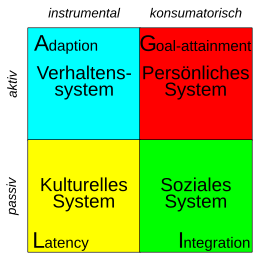AGIL scheme
The AGIL scheme is a systems theoretical model that was developed in the 1950s by the American sociologist Talcott Parsons . It systematically describes the basic functions that every system must fulfill for self-preservation. Initially designed as the basis of a theory of action, Parsons transferred the AGIL scheme to social systems in later works.
Basic concept
According to Talcott Parsons , every existing or conceivable system must fulfill four functions in order to maintain its existence:
- A daptation (alignment): to respond to changing external conditions, the ability of a system to adapt .
- G oal Attainment (tracking): the ability of a system that aims to define and pursue.
- I ntegration (inclusion): the ability of a system toestablish and secure cohesion (cohesion) and inclusion (inclusion).
- L atency or latent pattern maintenance : the ability of a system to maintain basic structures and value patterns .
Arrangement of the functions in a square grid
The functions are arranged according to two dichotomous criteria in a square grid:
- instrumental ↔ consumption
- The two instrumental functions "Adaptation" and "Latency" are on the left. They are called instrumental because they serve as an aid to other purposes.
- The two consumer functions “Goal Attainment” and “Integration” are on the right. They are called consumption because they provide direct benefit and can, to a certain extent , be consumed .
- active ↔ passive
- The two active functions "Adaptation" and "Goal Attainment" are at the top. They take on a more active, changing role.
- The two passive functions "Integration" and "Latency" are below. They take on a more passive, conservative role.
The horizontally adjacent sub-areas interact through symbolic means of exchange such as money , power , influence or value attachment .
In the order of “adaptation”, “goal attainment”, “integration” and “latency”, the enabling forces continue to decrease, while the order-creating forces increase more and more.
The action system
In order to be able to perform the four functions, a system forms specific subsystems that fulfill the respective task. In the most comprehensive and at the same time most abstract system, the system of action, these are:
- The behavior system ( adaptation ), it is based on needs .
- The personal system ( goal attainment ), it is based on motives . (Organized system of action orientations of an individual)
- The social system ( integration ), it is based on social roles . (System of interrelated actions of different actors)
- The cultural system ( latency ), it is based on values . (Organization of values, norms, symbols that influence the actions of the actors)
Every action , whether by individuals or collective actors of various kinds (groups or organizations) always results from these four components.
Note: The term social system has a double meaning within Parsons' theory. On the one hand, as described above, it is part of the human system of action, on the other hand, the term also describes social systems in the sense of structural functionalism .
- Subdivision into subsystems using the example of the social system
Each of these four subsystems is also subject to the AGIL scheme, so it can in turn be broken down into the four basic functions. In the case of the social system, these are the following four components:
- the economic system ( adaptation )
- the political system ( goal attainment )
- the community (system) ( integration )
- the cultural system ( latency )
Parsons and the system functionalism
Parsons is considered one of the founders of structural functionalism , but the AGIL scheme in particular clearly shows the inclusion of approaches from general systems theory . The resulting further development towards "system functionalism" laid the foundation for sociological systems theory .
literature
- Talcott Parsons : The Social System . Routledge, London 1951, ISBN 0-415-06055-9 (online) .

